Analysis of Risk Management in BBC's Digital Media Initiative Project
VerifiedAdded on 2023/01/17
|22
|5149
|1
Report
AI Summary
This report provides a detailed analysis of the BBC's Digital Media Initiative (DMI) project failure, examining the project's aims, goals, and the factors that led to its ultimate cancellation. The report utilizes the PMBOK methodology to assess risks, including internal and external factors contributing to cost overruns and timeline delays. It identifies key stakeholders, analyzes risks through a risk register and evaluation matrix, and proposes mitigation strategies. The analysis covers retrospective research into the project's history, including its outsourcing to Siemens and subsequent in-house efforts. Discussions and recommendations are provided to prevent similar failures in future digital media initiatives, and the report concludes with a comprehensive overview of the project's shortcomings and the lessons learned. The report also details a risk management plan and action plan for the project.
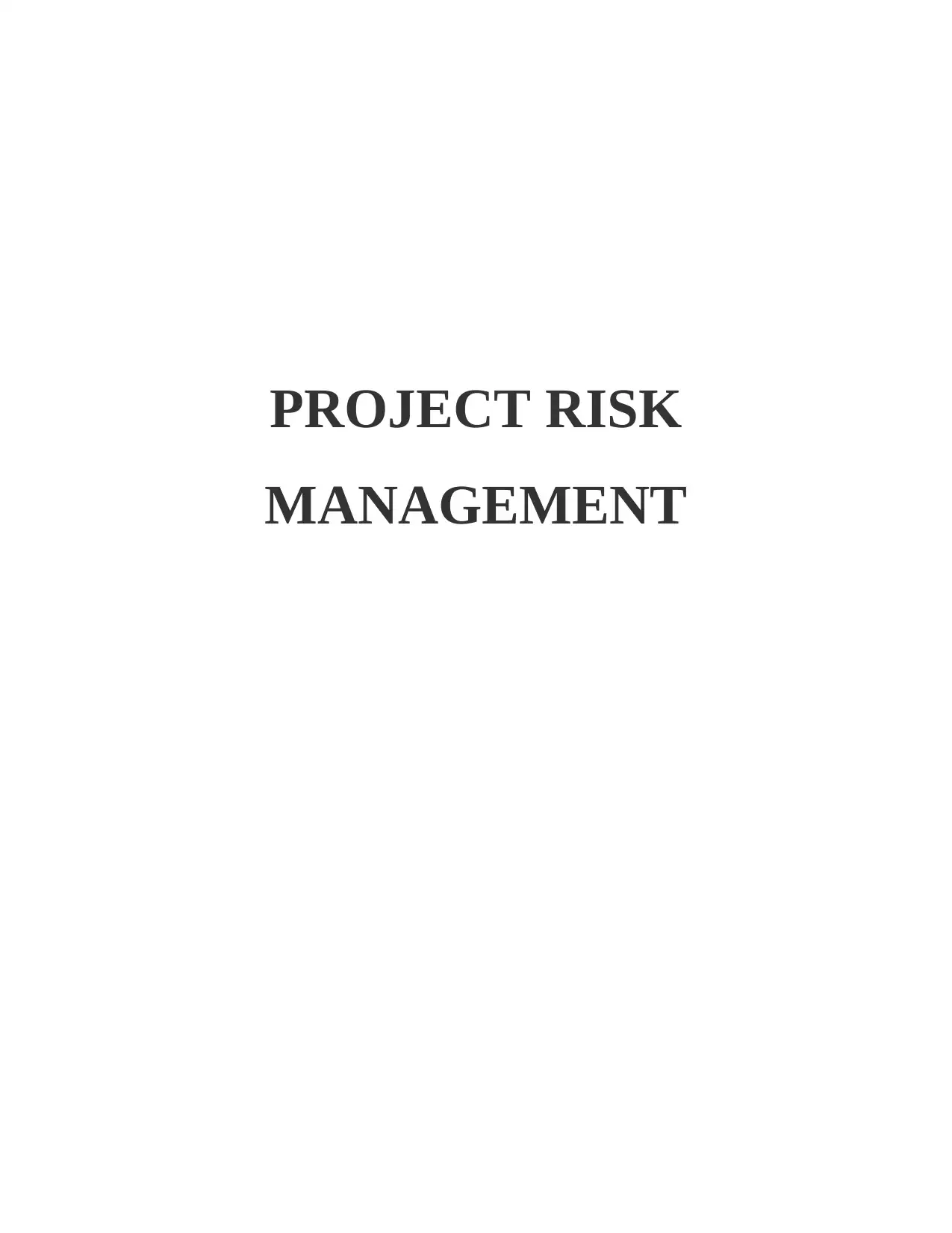
PROJECT RISK
MANAGEMENT
MANAGEMENT
Paraphrase This Document
Need a fresh take? Get an instant paraphrase of this document with our AI Paraphraser
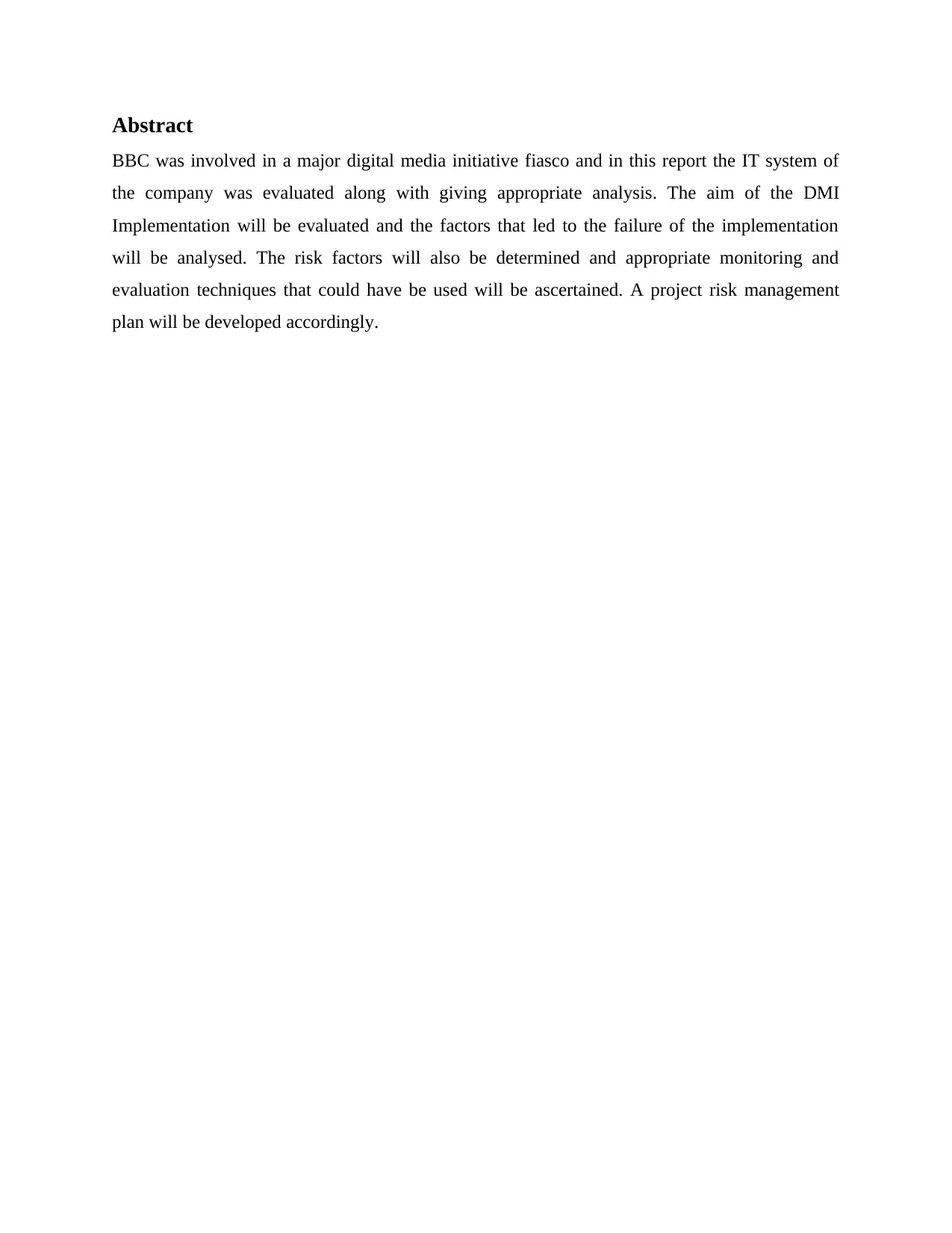
Abstract
BBC was involved in a major digital media initiative fiasco and in this report the IT system of
the company was evaluated along with giving appropriate analysis. The aim of the DMI
Implementation will be evaluated and the factors that led to the failure of the implementation
will be analysed. The risk factors will also be determined and appropriate monitoring and
evaluation techniques that could have be used will be ascertained. A project risk management
plan will be developed accordingly.
BBC was involved in a major digital media initiative fiasco and in this report the IT system of
the company was evaluated along with giving appropriate analysis. The aim of the DMI
Implementation will be evaluated and the factors that led to the failure of the implementation
will be analysed. The risk factors will also be determined and appropriate monitoring and
evaluation techniques that could have be used will be ascertained. A project risk management
plan will be developed accordingly.
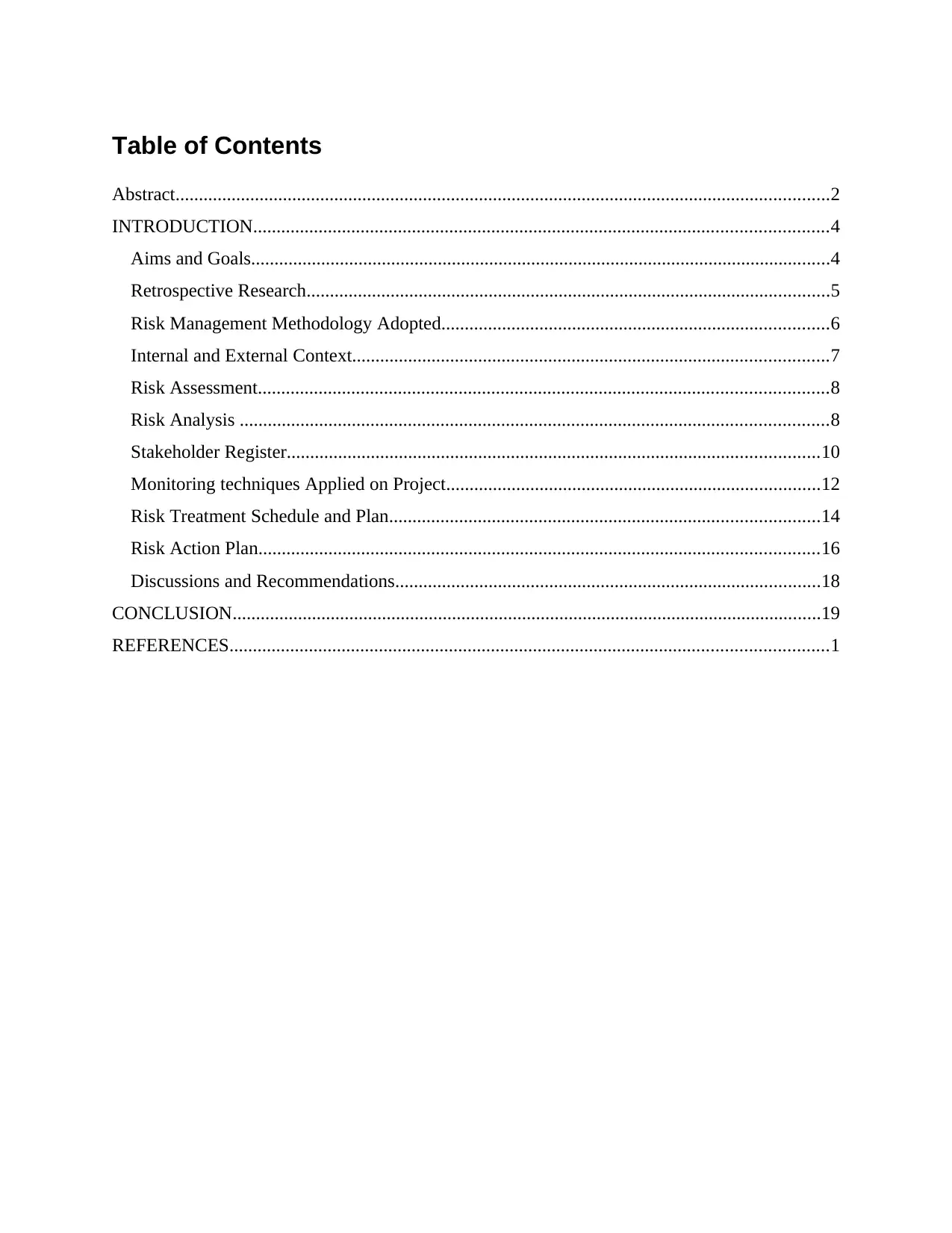
Table of Contents
Abstract............................................................................................................................................2
INTRODUCTION...........................................................................................................................4
Aims and Goals............................................................................................................................4
Retrospective Research................................................................................................................5
Risk Management Methodology Adopted...................................................................................6
Internal and External Context......................................................................................................7
Risk Assessment..........................................................................................................................8
Risk Analysis ..............................................................................................................................8
Stakeholder Register..................................................................................................................10
Monitoring techniques Applied on Project................................................................................12
Risk Treatment Schedule and Plan............................................................................................14
Risk Action Plan........................................................................................................................16
Discussions and Recommendations...........................................................................................18
CONCLUSION..............................................................................................................................19
REFERENCES................................................................................................................................1
Abstract............................................................................................................................................2
INTRODUCTION...........................................................................................................................4
Aims and Goals............................................................................................................................4
Retrospective Research................................................................................................................5
Risk Management Methodology Adopted...................................................................................6
Internal and External Context......................................................................................................7
Risk Assessment..........................................................................................................................8
Risk Analysis ..............................................................................................................................8
Stakeholder Register..................................................................................................................10
Monitoring techniques Applied on Project................................................................................12
Risk Treatment Schedule and Plan............................................................................................14
Risk Action Plan........................................................................................................................16
Discussions and Recommendations...........................................................................................18
CONCLUSION..............................................................................................................................19
REFERENCES................................................................................................................................1
⊘ This is a preview!⊘
Do you want full access?
Subscribe today to unlock all pages.

Trusted by 1+ million students worldwide
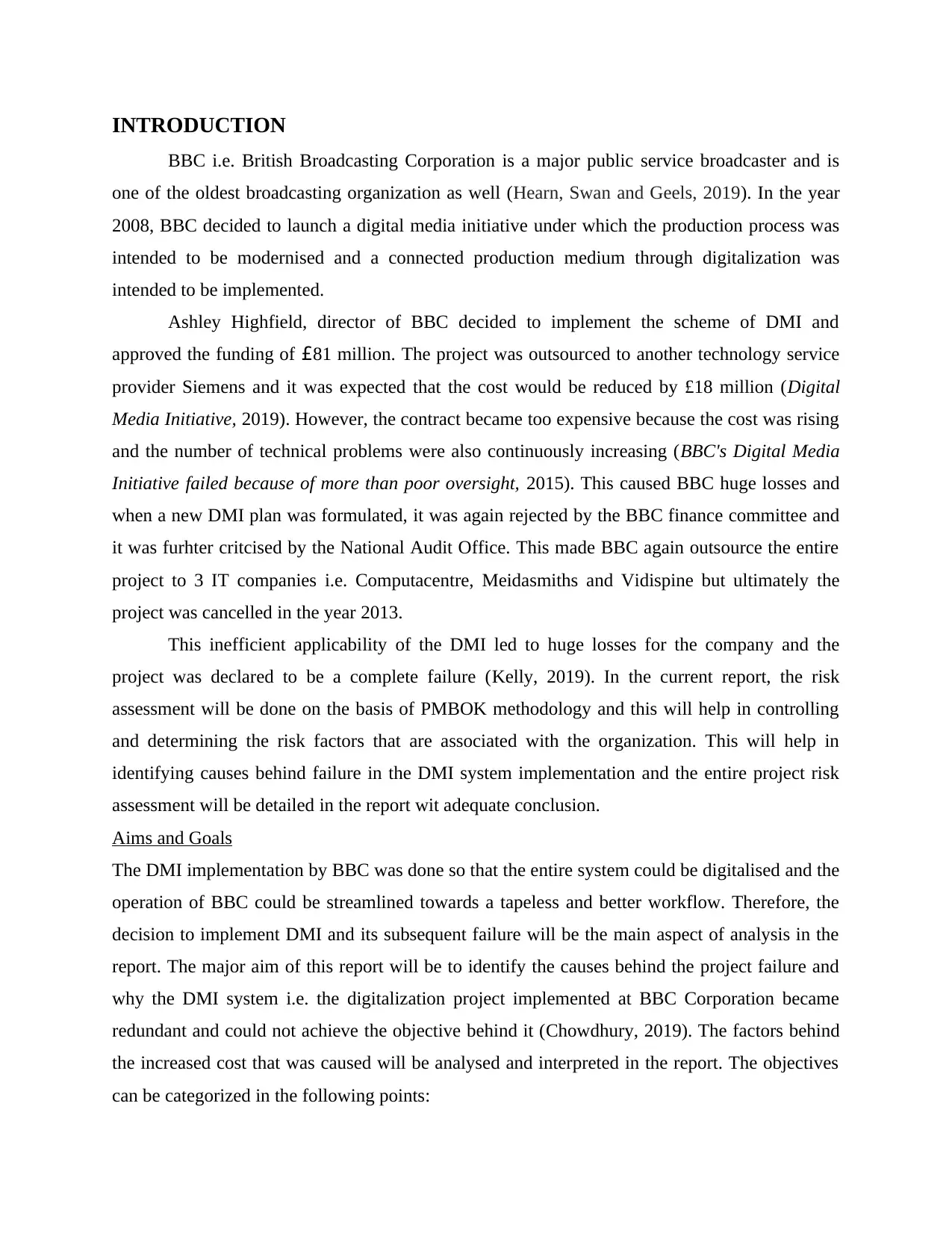
INTRODUCTION
BBC i.e. British Broadcasting Corporation is a major public service broadcaster and is
one of the oldest broadcasting organization as well (Hearn, Swan and Geels, 2019). In the year
2008, BBC decided to launch a digital media initiative under which the production process was
intended to be modernised and a connected production medium through digitalization was
intended to be implemented.
Ashley Highfield, director of BBC decided to implement the scheme of DMI and
approved the funding of £81 million. The project was outsourced to another technology service
provider Siemens and it was expected that the cost would be reduced by £18 million (Digital
Media Initiative, 2019). However, the contract became too expensive because the cost was rising
and the number of technical problems were also continuously increasing (BBC's Digital Media
Initiative failed because of more than poor oversight, 2015). This caused BBC huge losses and
when a new DMI plan was formulated, it was again rejected by the BBC finance committee and
it was furhter critcised by the National Audit Office. This made BBC again outsource the entire
project to 3 IT companies i.e. Computacentre, Meidasmiths and Vidispine but ultimately the
project was cancelled in the year 2013.
This inefficient applicability of the DMI led to huge losses for the company and the
project was declared to be a complete failure (Kelly, 2019). In the current report, the risk
assessment will be done on the basis of PMBOK methodology and this will help in controlling
and determining the risk factors that are associated with the organization. This will help in
identifying causes behind failure in the DMI system implementation and the entire project risk
assessment will be detailed in the report wit adequate conclusion.
Aims and Goals
The DMI implementation by BBC was done so that the entire system could be digitalised and the
operation of BBC could be streamlined towards a tapeless and better workflow. Therefore, the
decision to implement DMI and its subsequent failure will be the main aspect of analysis in the
report. The major aim of this report will be to identify the causes behind the project failure and
why the DMI system i.e. the digitalization project implemented at BBC Corporation became
redundant and could not achieve the objective behind it (Chowdhury, 2019). The factors behind
the increased cost that was caused will be analysed and interpreted in the report. The objectives
can be categorized in the following points:
BBC i.e. British Broadcasting Corporation is a major public service broadcaster and is
one of the oldest broadcasting organization as well (Hearn, Swan and Geels, 2019). In the year
2008, BBC decided to launch a digital media initiative under which the production process was
intended to be modernised and a connected production medium through digitalization was
intended to be implemented.
Ashley Highfield, director of BBC decided to implement the scheme of DMI and
approved the funding of £81 million. The project was outsourced to another technology service
provider Siemens and it was expected that the cost would be reduced by £18 million (Digital
Media Initiative, 2019). However, the contract became too expensive because the cost was rising
and the number of technical problems were also continuously increasing (BBC's Digital Media
Initiative failed because of more than poor oversight, 2015). This caused BBC huge losses and
when a new DMI plan was formulated, it was again rejected by the BBC finance committee and
it was furhter critcised by the National Audit Office. This made BBC again outsource the entire
project to 3 IT companies i.e. Computacentre, Meidasmiths and Vidispine but ultimately the
project was cancelled in the year 2013.
This inefficient applicability of the DMI led to huge losses for the company and the
project was declared to be a complete failure (Kelly, 2019). In the current report, the risk
assessment will be done on the basis of PMBOK methodology and this will help in controlling
and determining the risk factors that are associated with the organization. This will help in
identifying causes behind failure in the DMI system implementation and the entire project risk
assessment will be detailed in the report wit adequate conclusion.
Aims and Goals
The DMI implementation by BBC was done so that the entire system could be digitalised and the
operation of BBC could be streamlined towards a tapeless and better workflow. Therefore, the
decision to implement DMI and its subsequent failure will be the main aspect of analysis in the
report. The major aim of this report will be to identify the causes behind the project failure and
why the DMI system i.e. the digitalization project implemented at BBC Corporation became
redundant and could not achieve the objective behind it (Chowdhury, 2019). The factors behind
the increased cost that was caused will be analysed and interpreted in the report. The objectives
can be categorized in the following points:
Paraphrase This Document
Need a fresh take? Get an instant paraphrase of this document with our AI Paraphraser
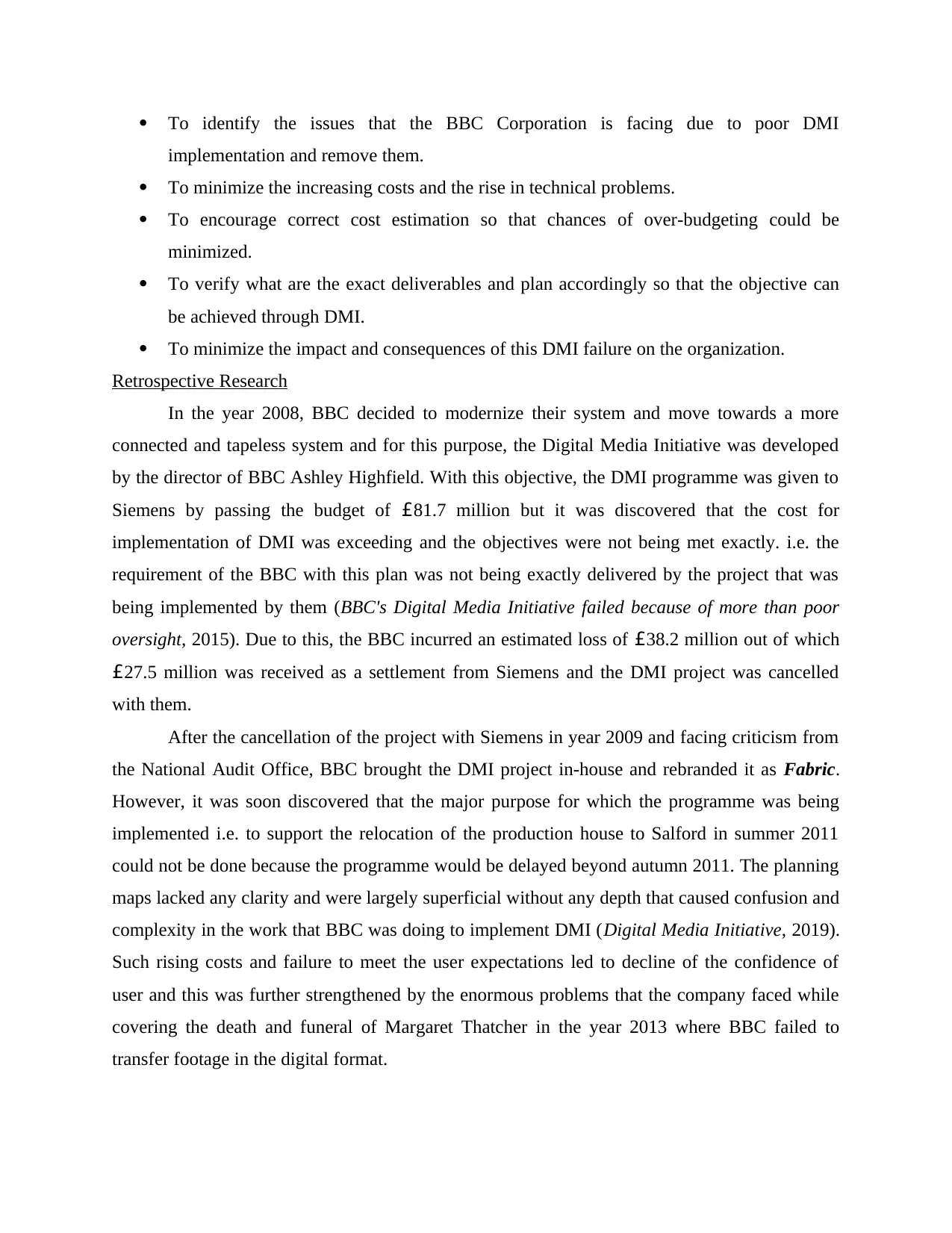
To identify the issues that the BBC Corporation is facing due to poor DMI
implementation and remove them.
To minimize the increasing costs and the rise in technical problems.
To encourage correct cost estimation so that chances of over-budgeting could be
minimized.
To verify what are the exact deliverables and plan accordingly so that the objective can
be achieved through DMI.
To minimize the impact and consequences of this DMI failure on the organization.
Retrospective Research
In the year 2008, BBC decided to modernize their system and move towards a more
connected and tapeless system and for this purpose, the Digital Media Initiative was developed
by the director of BBC Ashley Highfield. With this objective, the DMI programme was given to
Siemens by passing the budget of £81.7 million but it was discovered that the cost for
implementation of DMI was exceeding and the objectives were not being met exactly. i.e. the
requirement of the BBC with this plan was not being exactly delivered by the project that was
being implemented by them (BBC's Digital Media Initiative failed because of more than poor
oversight, 2015). Due to this, the BBC incurred an estimated loss of £38.2 million out of which
£27.5 million was received as a settlement from Siemens and the DMI project was cancelled
with them.
After the cancellation of the project with Siemens in year 2009 and facing criticism from
the National Audit Office, BBC brought the DMI project in-house and rebranded it as Fabric.
However, it was soon discovered that the major purpose for which the programme was being
implemented i.e. to support the relocation of the production house to Salford in summer 2011
could not be done because the programme would be delayed beyond autumn 2011. The planning
maps lacked any clarity and were largely superficial without any depth that caused confusion and
complexity in the work that BBC was doing to implement DMI (Digital Media Initiative, 2019).
Such rising costs and failure to meet the user expectations led to decline of the confidence of
user and this was further strengthened by the enormous problems that the company faced while
covering the death and funeral of Margaret Thatcher in the year 2013 where BBC failed to
transfer footage in the digital format.
implementation and remove them.
To minimize the increasing costs and the rise in technical problems.
To encourage correct cost estimation so that chances of over-budgeting could be
minimized.
To verify what are the exact deliverables and plan accordingly so that the objective can
be achieved through DMI.
To minimize the impact and consequences of this DMI failure on the organization.
Retrospective Research
In the year 2008, BBC decided to modernize their system and move towards a more
connected and tapeless system and for this purpose, the Digital Media Initiative was developed
by the director of BBC Ashley Highfield. With this objective, the DMI programme was given to
Siemens by passing the budget of £81.7 million but it was discovered that the cost for
implementation of DMI was exceeding and the objectives were not being met exactly. i.e. the
requirement of the BBC with this plan was not being exactly delivered by the project that was
being implemented by them (BBC's Digital Media Initiative failed because of more than poor
oversight, 2015). Due to this, the BBC incurred an estimated loss of £38.2 million out of which
£27.5 million was received as a settlement from Siemens and the DMI project was cancelled
with them.
After the cancellation of the project with Siemens in year 2009 and facing criticism from
the National Audit Office, BBC brought the DMI project in-house and rebranded it as Fabric.
However, it was soon discovered that the major purpose for which the programme was being
implemented i.e. to support the relocation of the production house to Salford in summer 2011
could not be done because the programme would be delayed beyond autumn 2011. The planning
maps lacked any clarity and were largely superficial without any depth that caused confusion and
complexity in the work that BBC was doing to implement DMI (Digital Media Initiative, 2019).
Such rising costs and failure to meet the user expectations led to decline of the confidence of
user and this was further strengthened by the enormous problems that the company faced while
covering the death and funeral of Margaret Thatcher in the year 2013 where BBC failed to
transfer footage in the digital format.
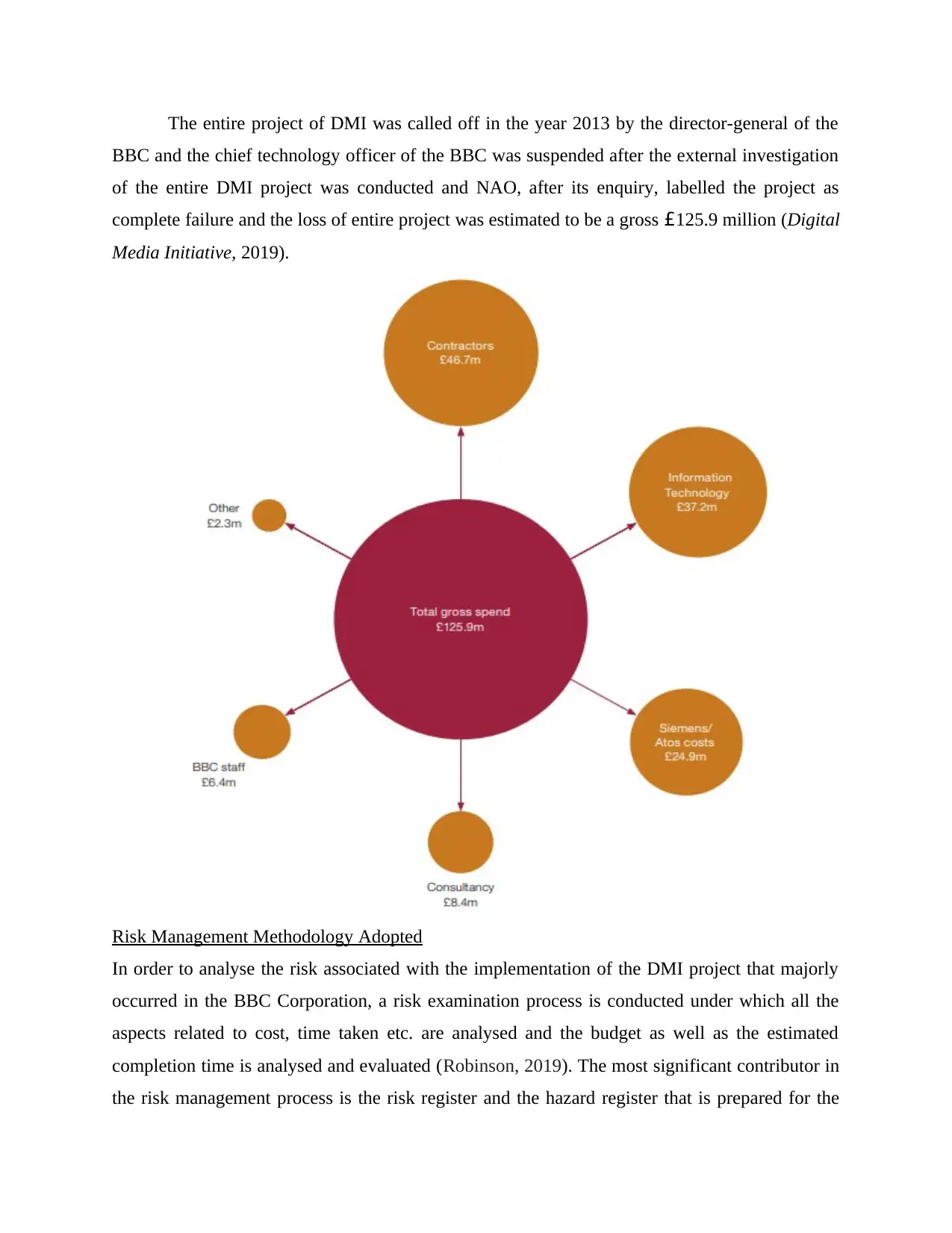
The entire project of DMI was called off in the year 2013 by the director-general of the
BBC and the chief technology officer of the BBC was suspended after the external investigation
of the entire DMI project was conducted and NAO, after its enquiry, labelled the project as
complete failure and the loss of entire project was estimated to be a gross £125.9 million (Digital
Media Initiative, 2019).
Risk Management Methodology Adopted
In order to analyse the risk associated with the implementation of the DMI project that majorly
occurred in the BBC Corporation, a risk examination process is conducted under which all the
aspects related to cost, time taken etc. are analysed and the budget as well as the estimated
completion time is analysed and evaluated (Robinson, 2019). The most significant contributor in
the risk management process is the risk register and the hazard register that is prepared for the
BBC and the chief technology officer of the BBC was suspended after the external investigation
of the entire DMI project was conducted and NAO, after its enquiry, labelled the project as
complete failure and the loss of entire project was estimated to be a gross £125.9 million (Digital
Media Initiative, 2019).
Risk Management Methodology Adopted
In order to analyse the risk associated with the implementation of the DMI project that majorly
occurred in the BBC Corporation, a risk examination process is conducted under which all the
aspects related to cost, time taken etc. are analysed and the budget as well as the estimated
completion time is analysed and evaluated (Robinson, 2019). The most significant contributor in
the risk management process is the risk register and the hazard register that is prepared for the
⊘ This is a preview!⊘
Do you want full access?
Subscribe today to unlock all pages.

Trusted by 1+ million students worldwide

organization. In the current report, for analysing the risks associated with the BBC Corporation,
the PMBOK process and method was adopted. The PMBOK process can be detailed as Project
Management Body of Knowledge and there are six major stages that are involved in the entire
risk management process:
Risk Management Planning
Identification of the risks Associated
Analysis of the Risk
Evaluation of the Risk
Executing the risk Management
Monitoring of the Risk
All these aspects of risks are associated with the implementation of the DMI system and these
help in determining what are the additional risks or dangers that are associated with the plan and
which steps can be adopted to mitigate these plans or actions (Bolutiwi, 2019).
Internal and External Context
The risks that were associated with the BBC Corporation can be classified into two major
categories i.e. internal risks and external risks that are prevalent in the context of the
implementation of the Digital Media Initiative in the organization:
Internal Risks: These are those risks that are associated within the organization and can be
controlled or tired to be mitigated by the employees and management working in the company
(Chapman, 2019). These can be categorized into following points:
The over budgeting or the excess incurring of expenditure than the estimated budget that
was prepared in the starting by Seimens.
The inefficient leadership in the company where the business objective or goals were not
clear and thus could not be integrated with the DMI.
Delay in the total implementation time of the DMI system in the BBC Corporation. Lack of any clarity regarding the goals and objectives of the organization and the purpose
for which they are developing a DMI system.
External Risks: These are those risks associated with th6e external environment over which the
management of the organization cannot be controlled and therefore these are not under their
control:
the PMBOK process and method was adopted. The PMBOK process can be detailed as Project
Management Body of Knowledge and there are six major stages that are involved in the entire
risk management process:
Risk Management Planning
Identification of the risks Associated
Analysis of the Risk
Evaluation of the Risk
Executing the risk Management
Monitoring of the Risk
All these aspects of risks are associated with the implementation of the DMI system and these
help in determining what are the additional risks or dangers that are associated with the plan and
which steps can be adopted to mitigate these plans or actions (Bolutiwi, 2019).
Internal and External Context
The risks that were associated with the BBC Corporation can be classified into two major
categories i.e. internal risks and external risks that are prevalent in the context of the
implementation of the Digital Media Initiative in the organization:
Internal Risks: These are those risks that are associated within the organization and can be
controlled or tired to be mitigated by the employees and management working in the company
(Chapman, 2019). These can be categorized into following points:
The over budgeting or the excess incurring of expenditure than the estimated budget that
was prepared in the starting by Seimens.
The inefficient leadership in the company where the business objective or goals were not
clear and thus could not be integrated with the DMI.
Delay in the total implementation time of the DMI system in the BBC Corporation. Lack of any clarity regarding the goals and objectives of the organization and the purpose
for which they are developing a DMI system.
External Risks: These are those risks associated with th6e external environment over which the
management of the organization cannot be controlled and therefore these are not under their
control:
Paraphrase This Document
Need a fresh take? Get an instant paraphrase of this document with our AI Paraphraser
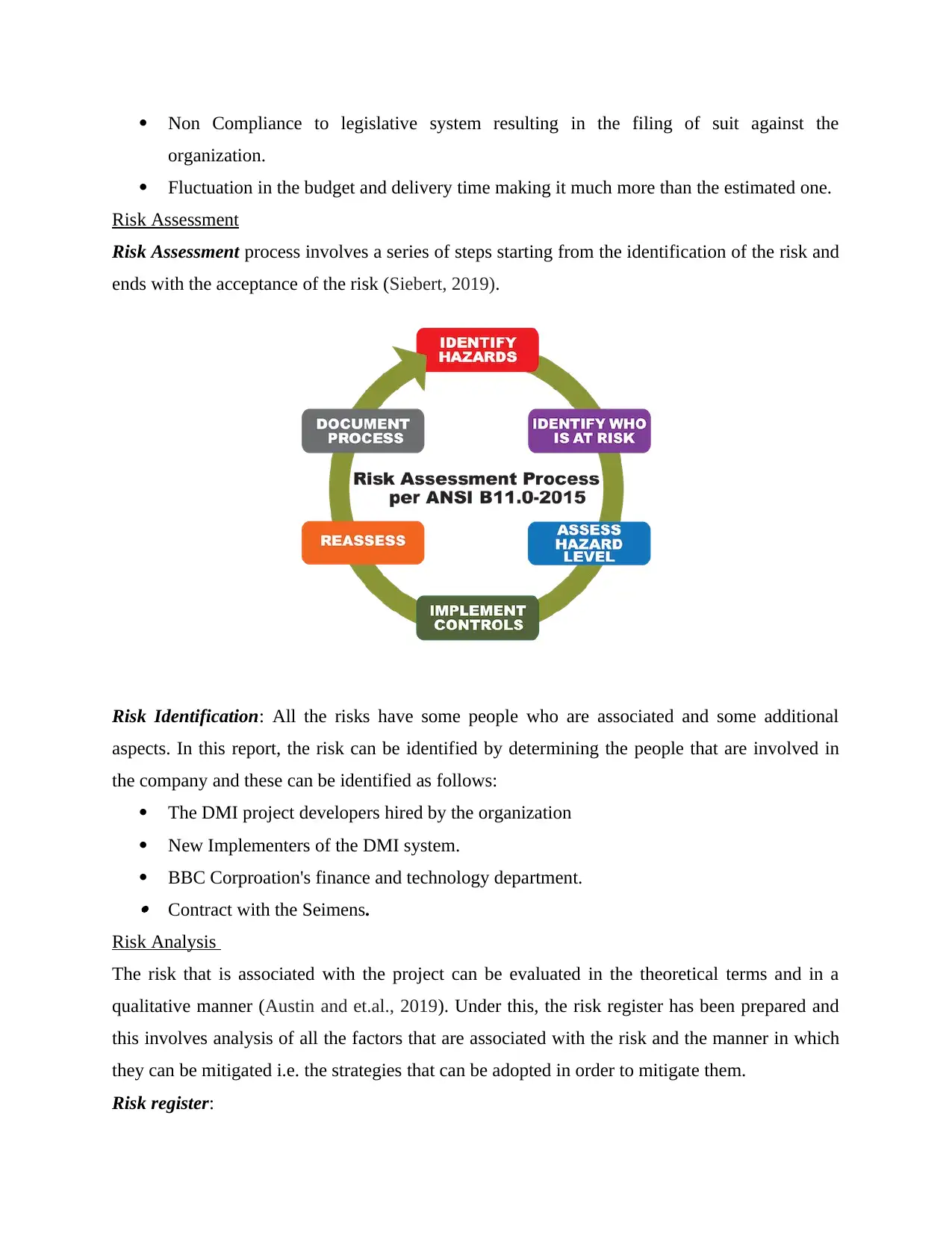
Non Compliance to legislative system resulting in the filing of suit against the
organization.
Fluctuation in the budget and delivery time making it much more than the estimated one.
Risk Assessment
Risk Assessment process involves a series of steps starting from the identification of the risk and
ends with the acceptance of the risk (Siebert, 2019).
Risk Identification: All the risks have some people who are associated and some additional
aspects. In this report, the risk can be identified by determining the people that are involved in
the company and these can be identified as follows:
The DMI project developers hired by the organization
New Implementers of the DMI system.
BBC Corproation's finance and technology department. Contract with the Seimens.
Risk Analysis
The risk that is associated with the project can be evaluated in the theoretical terms and in a
qualitative manner (Austin and et.al., 2019). Under this, the risk register has been prepared and
this involves analysis of all the factors that are associated with the risk and the manner in which
they can be mitigated i.e. the strategies that can be adopted in order to mitigate them.
Risk register:
organization.
Fluctuation in the budget and delivery time making it much more than the estimated one.
Risk Assessment
Risk Assessment process involves a series of steps starting from the identification of the risk and
ends with the acceptance of the risk (Siebert, 2019).
Risk Identification: All the risks have some people who are associated and some additional
aspects. In this report, the risk can be identified by determining the people that are involved in
the company and these can be identified as follows:
The DMI project developers hired by the organization
New Implementers of the DMI system.
BBC Corproation's finance and technology department. Contract with the Seimens.
Risk Analysis
The risk that is associated with the project can be evaluated in the theoretical terms and in a
qualitative manner (Austin and et.al., 2019). Under this, the risk register has been prepared and
this involves analysis of all the factors that are associated with the risk and the manner in which
they can be mitigated i.e. the strategies that can be adopted in order to mitigate them.
Risk register:
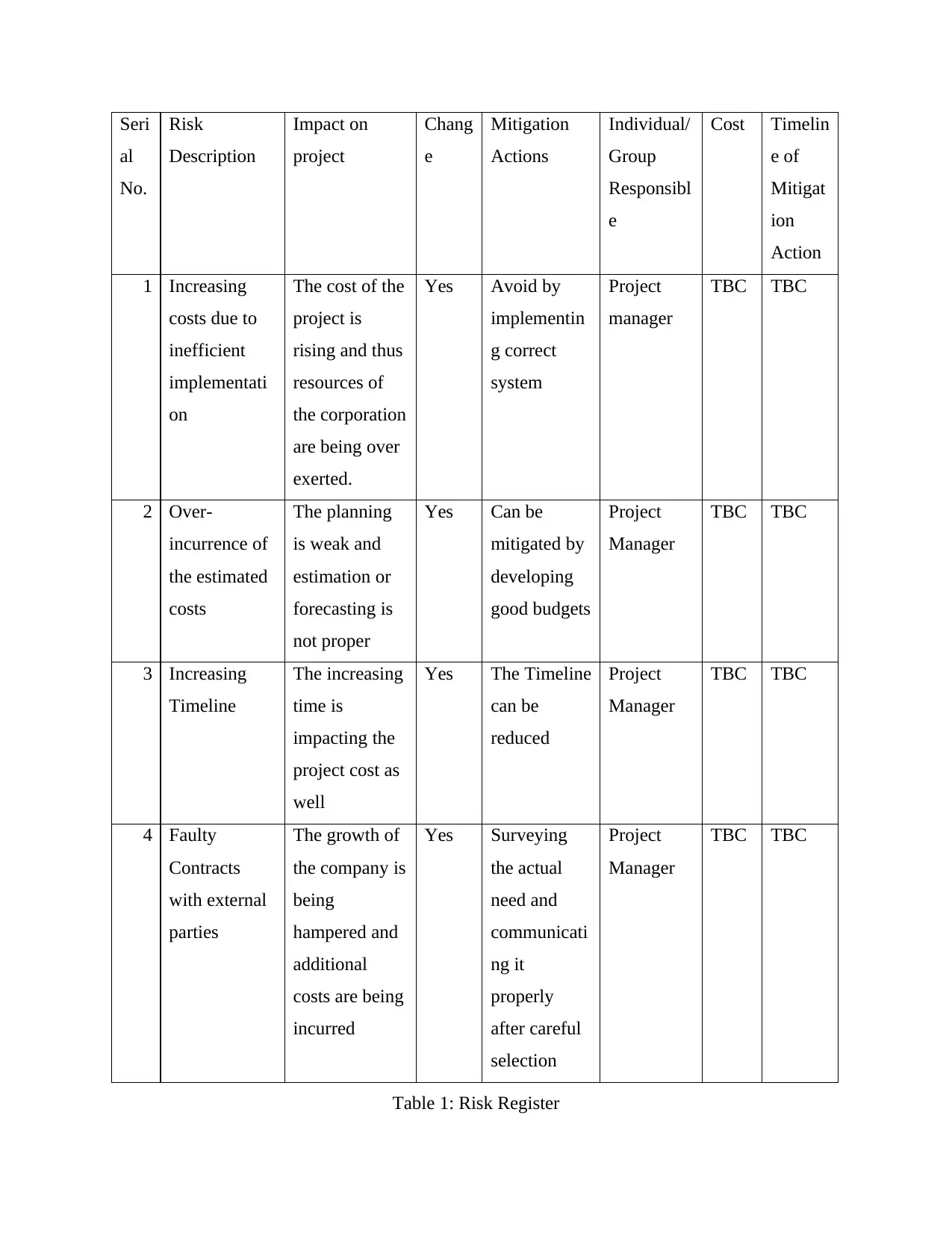
Seri
al
No.
Risk
Description
Impact on
project
Chang
e
Mitigation
Actions
Individual/
Group
Responsibl
e
Cost Timelin
e of
Mitigat
ion
Action
1 Increasing
costs due to
inefficient
implementati
on
The cost of the
project is
rising and thus
resources of
the corporation
are being over
exerted.
Yes Avoid by
implementin
g correct
system
Project
manager
TBC TBC
2 Over-
incurrence of
the estimated
costs
The planning
is weak and
estimation or
forecasting is
not proper
Yes Can be
mitigated by
developing
good budgets
Project
Manager
TBC TBC
3 Increasing
Timeline
The increasing
time is
impacting the
project cost as
well
Yes The Timeline
can be
reduced
Project
Manager
TBC TBC
4 Faulty
Contracts
with external
parties
The growth of
the company is
being
hampered and
additional
costs are being
incurred
Yes Surveying
the actual
need and
communicati
ng it
properly
after careful
selection
Project
Manager
TBC TBC
Table 1: Risk Register
al
No.
Risk
Description
Impact on
project
Chang
e
Mitigation
Actions
Individual/
Group
Responsibl
e
Cost Timelin
e of
Mitigat
ion
Action
1 Increasing
costs due to
inefficient
implementati
on
The cost of the
project is
rising and thus
resources of
the corporation
are being over
exerted.
Yes Avoid by
implementin
g correct
system
Project
manager
TBC TBC
2 Over-
incurrence of
the estimated
costs
The planning
is weak and
estimation or
forecasting is
not proper
Yes Can be
mitigated by
developing
good budgets
Project
Manager
TBC TBC
3 Increasing
Timeline
The increasing
time is
impacting the
project cost as
well
Yes The Timeline
can be
reduced
Project
Manager
TBC TBC
4 Faulty
Contracts
with external
parties
The growth of
the company is
being
hampered and
additional
costs are being
incurred
Yes Surveying
the actual
need and
communicati
ng it
properly
after careful
selection
Project
Manager
TBC TBC
Table 1: Risk Register
⊘ This is a preview!⊘
Do you want full access?
Subscribe today to unlock all pages.

Trusted by 1+ million students worldwide
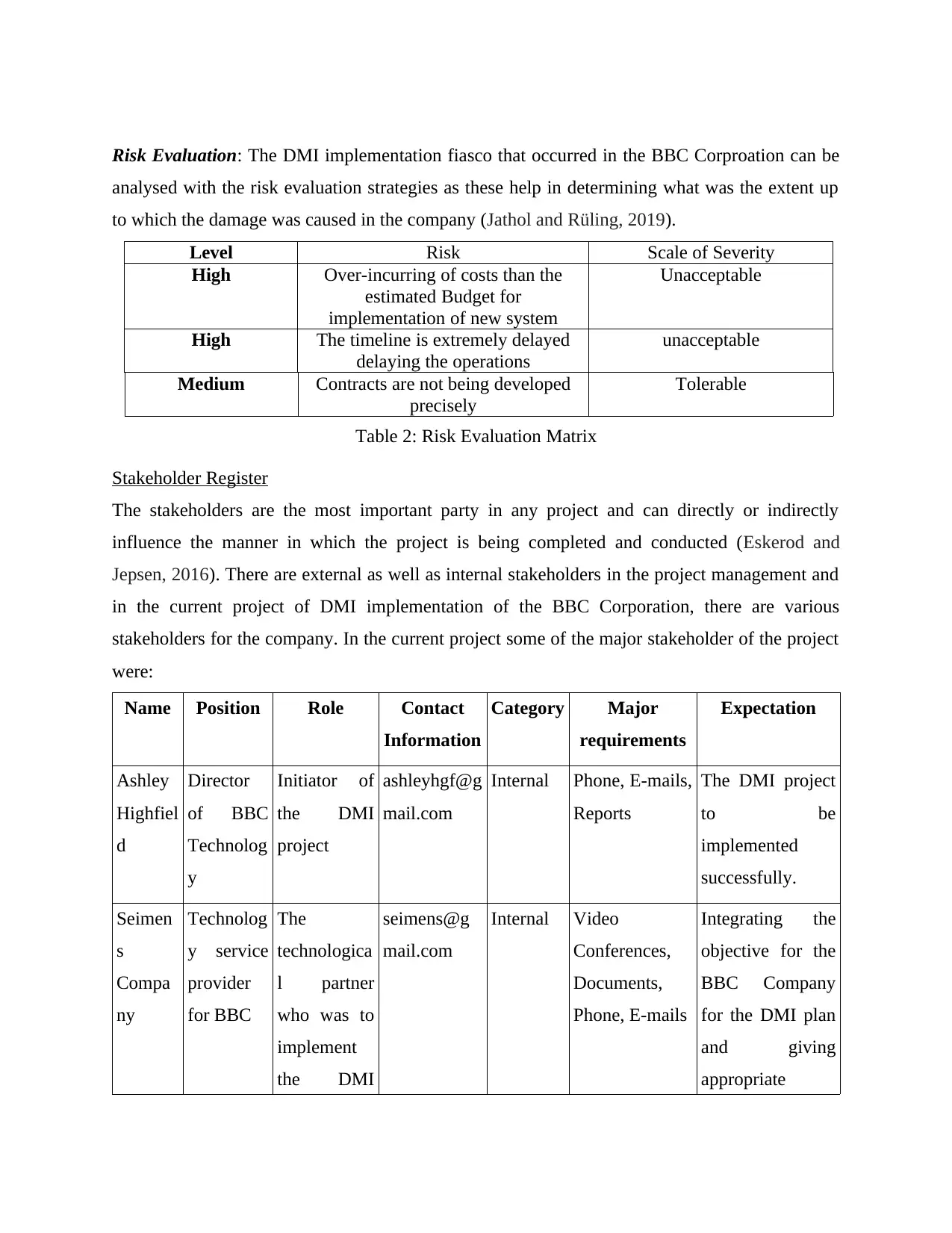
Risk Evaluation: The DMI implementation fiasco that occurred in the BBC Corproation can be
analysed with the risk evaluation strategies as these help in determining what was the extent up
to which the damage was caused in the company (Jathol and Rüling, 2019).
Level Risk Scale of Severity
High Over-incurring of costs than the
estimated Budget for
implementation of new system
Unacceptable
High The timeline is extremely delayed
delaying the operations
unacceptable
Medium Contracts are not being developed
precisely
Tolerable
Table 2: Risk Evaluation Matrix
Stakeholder Register
The stakeholders are the most important party in any project and can directly or indirectly
influence the manner in which the project is being completed and conducted (Eskerod and
Jepsen, 2016). There are external as well as internal stakeholders in the project management and
in the current project of DMI implementation of the BBC Corporation, there are various
stakeholders for the company. In the current project some of the major stakeholder of the project
were:
Name Position Role Contact
Information
Category Major
requirements
Expectation
Ashley
Highfiel
d
Director
of BBC
Technolog
y
Initiator of
the DMI
project
ashleyhgf@g
mail.com
Internal Phone, E-mails,
Reports
The DMI project
to be
implemented
successfully.
Seimen
s
Compa
ny
Technolog
y service
provider
for BBC
The
technologica
l partner
who was to
implement
the DMI
seimens@g
mail.com
Internal Video
Conferences,
Documents,
Phone, E-mails
Integrating the
objective for the
BBC Company
for the DMI plan
and giving
appropriate
analysed with the risk evaluation strategies as these help in determining what was the extent up
to which the damage was caused in the company (Jathol and Rüling, 2019).
Level Risk Scale of Severity
High Over-incurring of costs than the
estimated Budget for
implementation of new system
Unacceptable
High The timeline is extremely delayed
delaying the operations
unacceptable
Medium Contracts are not being developed
precisely
Tolerable
Table 2: Risk Evaluation Matrix
Stakeholder Register
The stakeholders are the most important party in any project and can directly or indirectly
influence the manner in which the project is being completed and conducted (Eskerod and
Jepsen, 2016). There are external as well as internal stakeholders in the project management and
in the current project of DMI implementation of the BBC Corporation, there are various
stakeholders for the company. In the current project some of the major stakeholder of the project
were:
Name Position Role Contact
Information
Category Major
requirements
Expectation
Ashley
Highfiel
d
Director
of BBC
Technolog
y
Initiator of
the DMI
project
ashleyhgf@g
mail.com
Internal Phone, E-mails,
Reports
The DMI project
to be
implemented
successfully.
Seimen
s
Compa
ny
Technolog
y service
provider
for BBC
The
technologica
l partner
who was to
implement
the DMI
seimens@g
mail.com
Internal Video
Conferences,
Documents,
Phone, E-mails
Integrating the
objective for the
BBC Company
for the DMI plan
and giving
appropriate
Paraphrase This Document
Need a fresh take? Get an instant paraphrase of this document with our AI Paraphraser
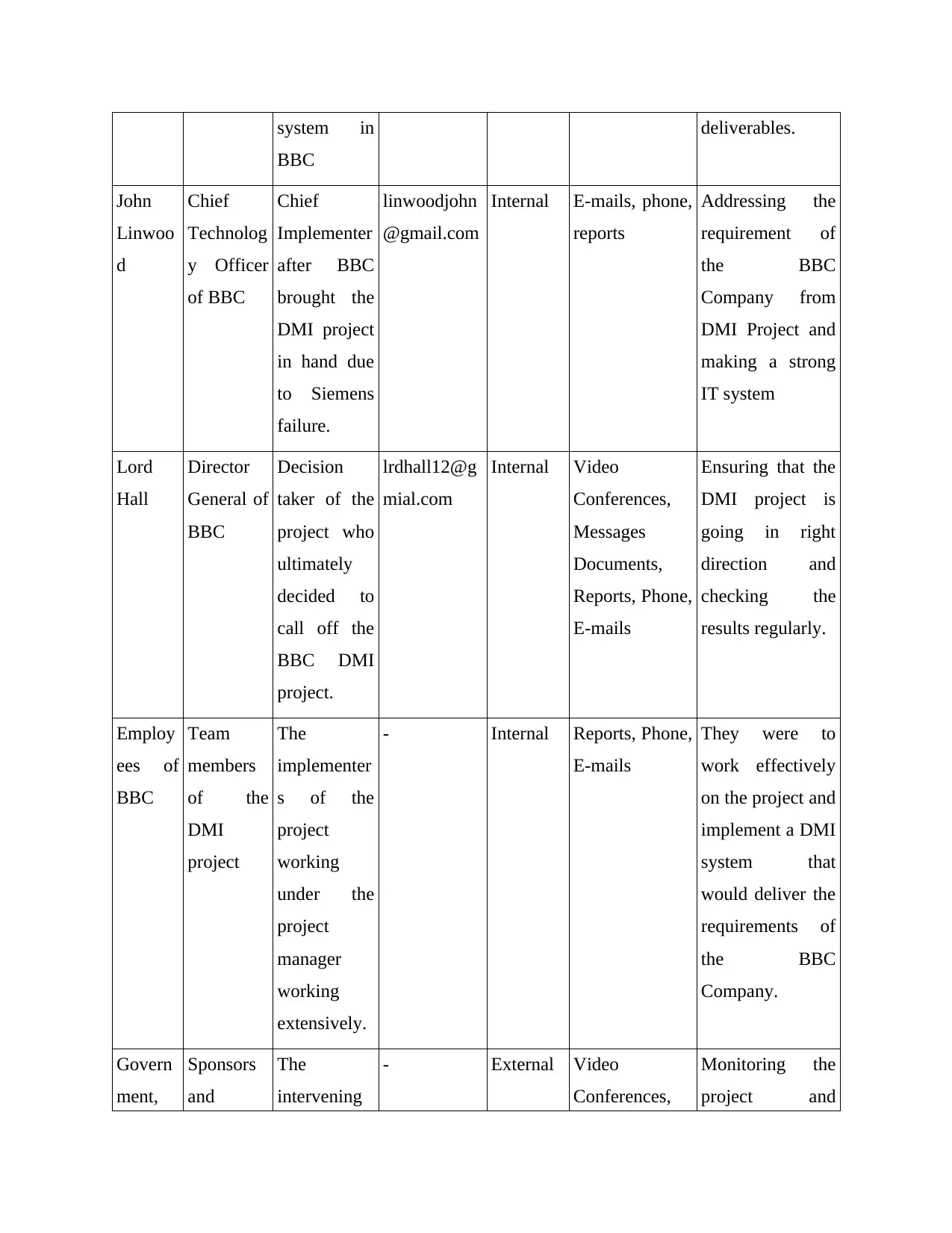
system in
BBC
deliverables.
John
Linwoo
d
Chief
Technolog
y Officer
of BBC
Chief
Implementer
after BBC
brought the
DMI project
in hand due
to Siemens
failure.
linwoodjohn
@gmail.com
Internal E-mails, phone,
reports
Addressing the
requirement of
the BBC
Company from
DMI Project and
making a strong
IT system
Lord
Hall
Director
General of
BBC
Decision
taker of the
project who
ultimately
decided to
call off the
BBC DMI
project.
lrdhall12@g
mial.com
Internal Video
Conferences,
Messages
Documents,
Reports, Phone,
E-mails
Ensuring that the
DMI project is
going in right
direction and
checking the
results regularly.
Employ
ees of
BBC
Team
members
of the
DMI
project
The
implementer
s of the
project
working
under the
project
manager
working
extensively.
- Internal Reports, Phone,
E-mails
They were to
work effectively
on the project and
implement a DMI
system that
would deliver the
requirements of
the BBC
Company.
Govern
ment,
Sponsors
and
The
intervening
- External Video
Conferences,
Monitoring the
project and
BBC
deliverables.
John
Linwoo
d
Chief
Technolog
y Officer
of BBC
Chief
Implementer
after BBC
brought the
DMI project
in hand due
to Siemens
failure.
linwoodjohn
@gmail.com
Internal E-mails, phone,
reports
Addressing the
requirement of
the BBC
Company from
DMI Project and
making a strong
IT system
Lord
Hall
Director
General of
BBC
Decision
taker of the
project who
ultimately
decided to
call off the
BBC DMI
project.
lrdhall12@g
mial.com
Internal Video
Conferences,
Messages
Documents,
Reports, Phone,
E-mails
Ensuring that the
DMI project is
going in right
direction and
checking the
results regularly.
Employ
ees of
BBC
Team
members
of the
DMI
project
The
implementer
s of the
project
working
under the
project
manager
working
extensively.
- Internal Reports, Phone,
E-mails
They were to
work effectively
on the project and
implement a DMI
system that
would deliver the
requirements of
the BBC
Company.
Govern
ment,
Sponsors
and
The
intervening
- External Video
Conferences,
Monitoring the
project and
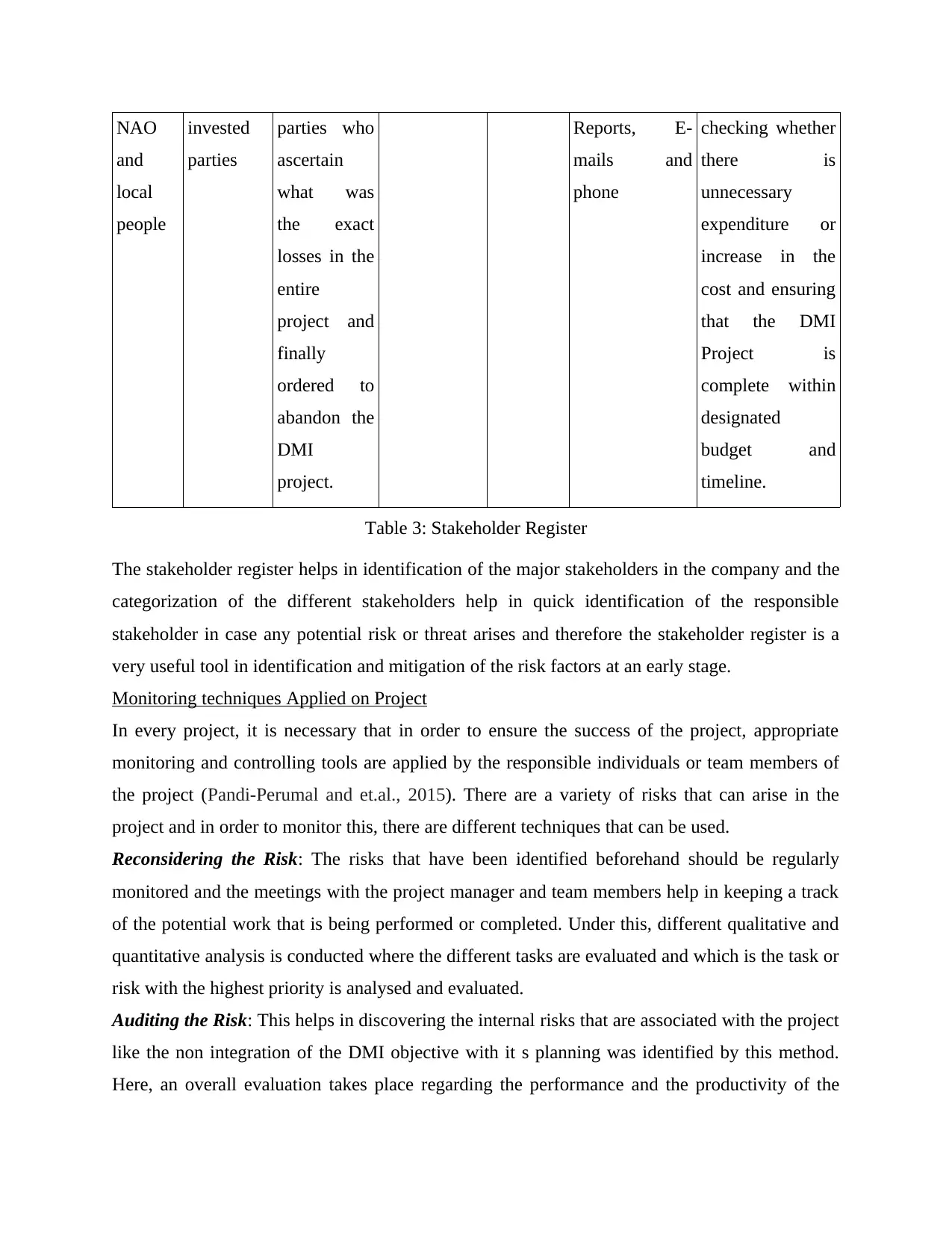
NAO
and
local
people
invested
parties
parties who
ascertain
what was
the exact
losses in the
entire
project and
finally
ordered to
abandon the
DMI
project.
Reports, E-
mails and
phone
checking whether
there is
unnecessary
expenditure or
increase in the
cost and ensuring
that the DMI
Project is
complete within
designated
budget and
timeline.
Table 3: Stakeholder Register
The stakeholder register helps in identification of the major stakeholders in the company and the
categorization of the different stakeholders help in quick identification of the responsible
stakeholder in case any potential risk or threat arises and therefore the stakeholder register is a
very useful tool in identification and mitigation of the risk factors at an early stage.
Monitoring techniques Applied on Project
In every project, it is necessary that in order to ensure the success of the project, appropriate
monitoring and controlling tools are applied by the responsible individuals or team members of
the project (Pandi-Perumal and et.al., 2015). There are a variety of risks that can arise in the
project and in order to monitor this, there are different techniques that can be used.
Reconsidering the Risk: The risks that have been identified beforehand should be regularly
monitored and the meetings with the project manager and team members help in keeping a track
of the potential work that is being performed or completed. Under this, different qualitative and
quantitative analysis is conducted where the different tasks are evaluated and which is the task or
risk with the highest priority is analysed and evaluated.
Auditing the Risk: This helps in discovering the internal risks that are associated with the project
like the non integration of the DMI objective with it s planning was identified by this method.
Here, an overall evaluation takes place regarding the performance and the productivity of the
and
local
people
invested
parties
parties who
ascertain
what was
the exact
losses in the
entire
project and
finally
ordered to
abandon the
DMI
project.
Reports, E-
mails and
phone
checking whether
there is
unnecessary
expenditure or
increase in the
cost and ensuring
that the DMI
Project is
complete within
designated
budget and
timeline.
Table 3: Stakeholder Register
The stakeholder register helps in identification of the major stakeholders in the company and the
categorization of the different stakeholders help in quick identification of the responsible
stakeholder in case any potential risk or threat arises and therefore the stakeholder register is a
very useful tool in identification and mitigation of the risk factors at an early stage.
Monitoring techniques Applied on Project
In every project, it is necessary that in order to ensure the success of the project, appropriate
monitoring and controlling tools are applied by the responsible individuals or team members of
the project (Pandi-Perumal and et.al., 2015). There are a variety of risks that can arise in the
project and in order to monitor this, there are different techniques that can be used.
Reconsidering the Risk: The risks that have been identified beforehand should be regularly
monitored and the meetings with the project manager and team members help in keeping a track
of the potential work that is being performed or completed. Under this, different qualitative and
quantitative analysis is conducted where the different tasks are evaluated and which is the task or
risk with the highest priority is analysed and evaluated.
Auditing the Risk: This helps in discovering the internal risks that are associated with the project
like the non integration of the DMI objective with it s planning was identified by this method.
Here, an overall evaluation takes place regarding the performance and the productivity of the
⊘ This is a preview!⊘
Do you want full access?
Subscribe today to unlock all pages.

Trusted by 1+ million students worldwide
1 out of 22
Related Documents
Your All-in-One AI-Powered Toolkit for Academic Success.
+13062052269
info@desklib.com
Available 24*7 on WhatsApp / Email
![[object Object]](/_next/static/media/star-bottom.7253800d.svg)
Unlock your academic potential
Copyright © 2020–2025 A2Z Services. All Rights Reserved. Developed and managed by ZUCOL.





